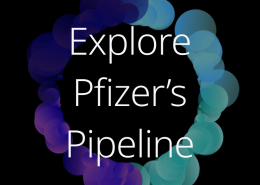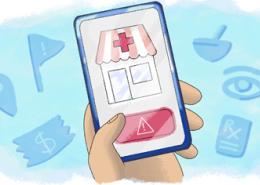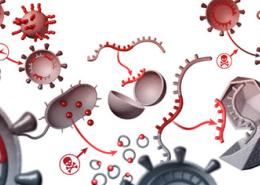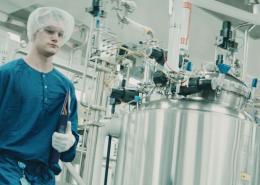Pfizer and BioNTech Provide Update on Ongoing Studies of COVID-19 Vaccine
NEW YORK and MAINZ, GERMANY, DECEMBER 17, 2021 — Pfizer Inc. (NYSE: PFE) and
BioNTech SE (Nasdaq: BNTX) today shared that following a routine review by the external independent Data Monitoring Committee (DMC), the companies will amend the clinical study evaluating the safety, tolerability, and immunogenicity of the Pfizer-BioNTech COVID-19 Vaccine in children 6 months to under 5 years of age. The study will now include evaluating a third dose of 3 µg at least two months after the second dose of the two-dose series to provide high levels of protection in this young age group.
While the study is ongoing and remains blinded, a pre-specified immunogenicity analysis was conducted on a subset of the study population one month following the second dose. Compared to the 16- to 25-year-old population in which high efficacy was demonstrated, non-inferiority was met for the 6- to 24-month-old population but not for the 2- to under 5-year-old population in this analysis. No safety concerns were identified and the 3 µg dose demonstrated a favorable safety profile in children 6 months to under 5 years of age.
The decision to evaluate a third dose of 3 µg for children 6 months to under 5 years of age reflects the companies’ commitment to carefully select the right dose to maximize the risk-
benefit profile. If the three-dose study is successful, Pfizer and BioNTech expect to submit data to regulators to support an Emergency Use Authorization (EUA) for children 6 months to under 5 years of age in the first half of 2022.
Pfizer and BioNTech also plan to evaluate a third dose of the 10 µg formulation in children 5 to under 12 years of age.
Furthermore, the companies have initiated a low dose sub-study of a third dose of 10 µg or 30 µg in approximately 600 adolescents aged 12- to 17, to assess safety and immunogenicity.
These updates were informed by the effectiveness data for three doses of the vaccine for people 16 years and older, and the early laboratory data observed with Delta and other variants of concern, including Omicron, which suggest that people vaccinated with three doses of a COVID- 19 vaccine may have a higher degree of protection.
These changes have been endorsed by and agreed upon with the U.S. Food and Drug Administration.
About the Phase 1/2/3 Trial in Children
The Phase 1/2/3 trial initially enrolled up to 4,500 children ages 6 months to under 12 years of age in the United States, Finland, Poland, and Spain from more than 90 clinical trial sites. It was
designed to evaluate the safety, tolerability, and immunogenicity of the Pfizer -BioNTech vaccine on a two-dose schedule (approximately 21 days apart) in three age groups: ages 5 to under 12 years; ages 2 to under 5 years; and ages 6 months to under 2 years. Based on the Phase 1 dose- escalation portion of the trial, children ages 5 to under 12 years received a two-dose schedule of 10 µg each while children under age 5 received a lower 3 µg dose for each injection in the Phase 2/3 study. The trial enrolled children with or without prior evidence of SARS-CoV-2 infection.
The Pfizer-BioNTech COVID-19 Vaccine, which is based on BioNTech’s proprietary mRNA technology, was developed by both BioNTech and Pfizer. BioNTech is the Marketing Authorization Holder in the United States, the European Union, the United Kingdom, Canada and other countries, and the holder of emergency use authorizations or equivalents in the United States (jointly with Pfizer) and other countries. Submissions to pursue regulatory approvals in those countries where emergency use authorizations or equivalent were initially granted are planned.
U.S. Indication & Authorized Use
HOW IS THE VACCINE GIVEN?
The vaccine will be given as an injection into the muscle. Primary Series:
In individuals 5 years of age and older, the vaccine is administered as a 2-dose series, 3 weeks
apart. In individuals 12 years of age and older, a third primary series dose may be administered at least 4 weeks after the second dose to individuals who are determined to have certain kin ds of immunocompromise.
Booster Dose:
• A single booster dose of the vaccine may be administered at least 6 months after completion of a primary series to individuals 18 years of age and older
• A single booster dose of the vaccine may be administered to individuals 18 years of age and older who have completed primary vaccination with a different authorized COVID-19 vaccine. Individuals should check with their healthcare provider regarding timing of the booster dose
WHAT IS THE INDICATION AND AUTHORIZED USE?
The Pfizer-BioNTech COVID-19 Vaccine has received EUA from FDA to provide:
• a 2-dose primary series to individuals 5 years of age and older
• a third primary series dose to individuals 12 years of age and older who have been determined to have certain kinds of immunocompromise
• a single booster dose to individuals 16 years of age and older who have completed a primary series with Pfizer-BioNTech COVID-19 Vaccine or COMIRNATY®
• a single booster dose to individuals 16 years of age and older who have completed primary vaccination with a different authorized COVID-19 vaccine. The booster schedule is based on the labeling information of the vaccine used for the primary series
COMIRNATY® (COVID-19 Vaccine, mRNA) is an FDA-approved COVID-19 vaccine made by Pfizer for BioNTech.
• It is approved as a 2-dose series for prevention of COVID-19 in individuals 16 years of age and older
• It is also authorized under EUA to provide:
o a 2-dose primary series to individuals 12 through 15 years of age
o a third primary series dose to individuals 12 years of age and older who have been determined to have certain kinds of immunocompromise
o a single booster dose to individuals 16 years of age and older who have completed a primary series with Pfizer-BioNTech COVID-19 Vaccine or COMIRNATY®
o a single booster dose to individuals 16 years of age and older who have completed primary vaccination with a different authorized COVID-19 vaccine. The booster schedule is based on the labeling information of the vaccine used for the primary series
EUA Statement
Emergency uses of the vaccine have not been approved or licensed by FDA, but have been authorized by FDA, under an Emergency Use Authorization (EUA) to prevent Coronavirus Disease 2019 (COVID-19) in individuals 5 years of age and older. The emergency uses are only authorized for the duration of the declaration that circumstances exist justifying the authorization of emergency use of the medical product under Section 564(b)(1) of the FD&C Act unless the declaration is terminated or authorization revoked sooner. Please see EUA Fact Sheets
at www.cvdvaccine-us.com.
IMPORTANT SAFETY INFORMATION
Individuals should not get the vaccine if they:
• had a severe allergic reaction after a previous dose of this vaccine
• had a severe allergic reaction to any ingredient of this vaccine
Individuals should tell the vaccination provider about all of their medical conditions, including if they:
• have any allergies
• have had myocarditis (inflammation of the heart muscle) or pericarditis (inflammation of the lining outside the heart)
• have a fever
• have a bleeding disorder or are on a blood thinner
• are immunocompromised or are on a medicine that affects the immune system
• are pregnant, plan to become pregnant, or are breastfeeding
• have received another COVID-19 vaccine
• have ever fainted in association with an injection The vaccine may not protect everyone.
Side effects reported with the vaccine include:
• There is a remote chance that the vaccine could cause a severe allergic reaction
o A severe allergic reaction would usually occur within a few minutes to 1 hour after getting a dose of the vaccine. For this reason, vaccination providers may ask individuals to stay at the place where they received the vaccine for monitoring after vaccination
o Signs of a severe allergic reaction can include difficulty breathing, swelling of the face and throat, a fast heartbeat, a bad rash all over the body, dizziness, and weakness
o If an individual experiences a severe allergic reaction, they should call 9 -1-1 or go to the nearest hospital
• Myocarditis (inflammation of the heart muscle) and pericarditis (inflammation of the lining outside the heart) have occurred in some people who have received the vaccine, more commonly in males under 40 years of age than among females and older males. In most of these people, symptoms began within a few days following receipt of the second dose of the vaccine. The chance of having this occur is very low. Individuals should seek medical attention right away if they have any of the following symptoms after receiving the vaccine:
o chest pain
o shortness of breath
o feelings of having a fast-beating, fluttering, or pounding heart
• Additional side effects that have been reported with the vaccine include:
o severe allergic reactions; non-severe allergic reactions such as rash, itching, hives, or swelling of the face; myocarditis (inflammation of the heart muscle); pericarditis (inflammation of the lining outside the heart); injection site pain; tiredness; headache; muscle pain; chills; joint pain; fever; injection site swelling; injection site redness; nausea; feeling unwell; swollen lymph nodes (lymphadenopathy); decreased appetite; diarrhea; vomiting; arm pain; fainting in association with injection of the vaccine
• These may not be all the possible side effects of the vaccine. Serious and unexpected
side effects may occur. The possible side effects of the vaccine are still being studied in clinical trials. Call the vaccination provider or healthcare provider about bothersome side effects or side effects that do not go away
Data on administration of this vaccine at the same time as other vaccines have not yet been submitted to FDA. Individuals considering receiving this vaccine with other vaccines, should discuss their options with their healthcare provider.
Patients should always ask their healthcare providers for medical advice about adverse events. Individuals are encouraged to report negative side effects of vaccines to the US Food and Drug Administration (FDA) and the Centers for Disease Control and Prevention (CDC).
Visit https://www.vaers.hhs.gov or call 1-800-822-7967. In addition, side effects can be reported to Pfizer Inc. at www.pfizersafetyreporting.com or by calling 1-800-438-1985.
Click for
Fact Sheets and Prescribing Information for individuals 12 years of age and older
Full Prescribing Information (16 years of age and older)
EUA Fact Sheet for Vaccination Providers (12 years of age and older), Purple Cap
EUA Fact Sheet for Vaccination Providers (12 years of age and older), Gray Cap Recipients and Caregivers Fact Sheet (12 years of age and older)
Fact Sheets for individuals 5 through 11 years of age
EUA Fact Sheet for Vaccination Providers (5 through 11 years of age), Orange Cap
Recipients and Caregivers Fact Sheet (5 through 11 years of age)
About Pfizer: Breakthroughs That Change Patients’ Lives
At Pfizer, we apply science and our global resources to bring therapies to people that extend and significantly improve their lives. We strive to set the standard for quality, safety and value in the discovery, development and manufacture of health care products, including innovative medicines and vaccines. Every day, Pfizer colleagues work across developed and emerging markets to advance wellness, prevention, treatments and cures that challenge the most feared diseases of our time. Consistent with our responsibility as one of the world's premier innovative biopharmaceutical companies, we collaborate with health care providers, governments and local communities to support and expand access to reliable, affordable health care around the world. For more than 170 years, we have worked to make a difference for all who rely on us. We routinely post information that may be important to investors on our website at www.Pfizer.com.
In addition, to learn more, please visit us on www.Pfizer.com and follow us on Twitter at @Pfizer and @Pfizer News, LinkedIn, YouTube and like us on Facebook
at Facebook.com/Pfizer.
Pfizer Disclosure Notice
The information contained in this release is as of December 17, 2021. Pfizer assumes no obligation to update forward-looking statements contained in this release as the result of new information or future events or developments.
This release contains forward-looking information about Pfizer’s efforts to combat COVID-19, the collaboration between BioNTech and Pfizer to develop a COVID-19 vaccine, the BNT162b2 mRNA vaccine program, and the Pfizer-BioNTech COVID-19 Vaccine (BNT162b2) (including its potential in children 6 months to under 5 years of age, booster doses, qualitative assessments of available data, potential benefits, expectations for clinical trials, the anticipated timing of data readouts, regulatory submissions, regulatory approvals or authorizations and anticipated
manufacturing, distribution and supply) involving substantial risks and uncertainties that could cause actual results to differ materially from those expressed or implied by su ch statements. Risks and uncertainties include, among other things, the uncertainties inherent in research and development, including the ability to meet anticipated clinical endpoints, commencement and/or completion dates for clinical trials, regulatory submission dates, regulatory approval dates and/or launch dates, as well as risks associated with preclinical and clinical data (including the Phase 3 data), including the possibility of unfavorable new preclinical, clinical or safety data and further analyses of existing preclinical, clinical or safety data; the ability to produce comparable clinical or other results, including the rate of vaccine effectiveness and safety and tolerability profile observed to date, in additional analyses of the Phase 3 trial and additional studies or in larger, more diverse populations following commercialization; the ability of BNT162b2 to prevent COVID-19 caused by emerging virus variants; the risk that more widespread use of the vaccine will lead to new information about efficacy, safety, or other developments, including the risk of additional adverse reactions, some of which may be serious; the risk that preclinical and clinical trial data are subject to differing interpretations and assessments, including during the peer review/publication process, in the scientific community generally, and by regulatory authorities; whether and when additional data from the BNT162 mRNA vaccine program will be published in scientific journal publications and, if so, when and with what modifications and interpretations; whether regulatory authorities will be satisfied with the design of and results from these and any future preclinical and clinical studies; whether and when potential submissions for EUA in children 6 months to under 5 years of age will be submitted and whether and when submissions to request emergency use or conditional marketing authorizations for a potential booster dose, pediatric populations and/or other biologics license and/or emergency use authorization applications or amendments to any such applications may be filed in particular jurisdictions for BNT162b2 or any other potential vaccines that may arise from the BNT162 program, and if
obtained, whether or when such emergency use authorizations or licenses will expire o r terminate; whether and when any applications that may be pending or filed for BNT162b2 (including potential EUA submissions in children 6 months to under 5 years of age and any requested amendments to the emergency use or conditional marketing authorizat ions) or other vaccines that may result from the BNT162 program may be approved by particular regulatory authorities, which will depend on myriad factors, including making a determination as to whether the vaccine’s benefits outweigh its known risks and determination of the vaccine’s efficacy and, if approved, whether it will be commercially successful; decisions by regulatory authorities impacting labeling or marketing, manufacturing processes, safety and/or other matters that could affect the availability or commercial potential of a vaccine, including development of products or therapies by other companies; disruptions in the relationships between us and our collaboration partners, clinical trial sites or third-party suppliers; the risk that demand for any products may be reduced or no longer exist; risks related to the availability of raw materials to manufacture a vaccine; challenges related to our vaccine’s formulation, two-dose schedule and attendant storage, distribution and administration requirements, including risks related to storage and handling after delivery by Pfizer; the risk that we may not be able to successfully develop other vaccine formulations, booster doses or new variant -specific vaccines; the risk that we may not be able to create or scale up manufacturing capacity on a timely basis or maintain access to logistics or supply channels commensurate with global demand for our vaccine, which would negatively impact our ability to supply the estimated numbers of doses of our vaccine within the projected time periods as previously indicated; whether and when additional supply agreements will be reached; uncertainties regarding the ability to obtain recommendations from vaccine advisory or technical committees and other public health authorities and uncertainties regarding the commercial impact of any such recommendations; challenges related to public vaccine confidence or awareness; uncertainties regarding the impact of COVID-19 on Pfizer’s business, operations and financial results; and competitive developments.
A further description of risks and uncertainties can be found in Pfizer’s Annual Report on Form 10-K for the fiscal year ended December 31, 2020 and in its subsequent reports on Form 10 -Q, including in the sections thereof captioned “Risk Factors” and “Forward-Looking Information and Factors That May Affect Future Results”, as well as in its subsequent reports on Form 8 -K, all of which are filed with the U.S. Securities and Exchange Commission and available
at www.sec.gov and www.pfizer.com.
About BioNTech
Biopharmaceutical New Technologies is a next generation immunotherapy company pioneering novel therapies for cancer and other serious diseases. The Company exploits a wide array of computational discovery and therapeutic drug platforms for the rapid development of novel biopharmaceuticals. Its broad portfolio of oncology product candidates includes individualized and off-the-shelf mRNA-based therapies, innovative chimeric antigen receptor T cells, bi- specific checkpoint immuno-modulators, targeted cancer antibodies and small molecules.
Based on its deep expertise in mRNA vaccine development and in-house manufacturing capabilities, BioNTech and its collaborators are developing multiple mRNA vaccine candidates for a range of infectious diseases alongside its diverse oncology pipeline. BioNTech has established a broad set of relationships with multiple global pharmaceutical collaborators, including Genmab, Sanofi, Bayer Animal Health, Genentech, a member of the Roche Group,
Regeneron, Genevant, Fosun Pharma, and Pfizer. For more information, please visit www.BioNTech.de.
BioNTech Forward-looking Statements
This press release contains “forward-looking statements” of BioNTech within the meaning of the
Private Securities Litigation Reform Act of 1995. These forward-looking statements may include, but may not be limited to, statements concerning: BioNTech’s efforts to combat COVID-19; the collaboration between BioNTech and Pfizer including the program to develop a COVID-19 vaccine and COMIRNATY (COVID-19 Vaccine, mRNA) (BNT162b2) (including its potential in children 6 months to under 5 years of age, the potential of booster doses, the planned submissions globally to request approval of BNT162b2 in individuals 12 years of age and older, qualitative assessments of available data, potential benefits, expectations for clinical trials, the anticipated timing of regulatory submissions, regulatory approvals or authorizations and anticipated manufacturing, distribution and supply); our expectations regarding the potential characteristics of BNT162b2 in our clinical trials and/or in commercial use based on data observations to date; the ability of BNT162b2 to prevent COVID-19 caused by emerging virus variants; the expected time point for additional readouts on efficacy data of BNT162b2 in our clinical trials; the nature of the clinical data, which is subject to ongoing peer review, regulatory review and market interpretation; the timing for submission s of data for, or receipt of, any marketing approval or Emergency Use Authorization for BNT162b2 or any other potential vaccine that may be developed from the BNT162 program; if such emergency use authorization or marketing approval is obtained, whether and when they will expire; our contemplated shipping and storage plan, including our estimated product shelf life at various temperatures; the ability of BioNTech to supply the quantities of BNT162 to support clinical development and market demand, including our production estimates for 2021; challenges related to public vaccine confidence or awareness; and uncertainties regarding the impact of COVID-19 on BioNTech’s trials, business and general operations. Any forward-looking statements in this press release are based on BioNTech current expectations and beliefs of future events, and are subject to a number of risks and uncertainties that could cause actual results to differ materially and adversely from those set forth in or implied by such forward-looking statements. These risks and uncertainties include, but are not limited to: the ability to meet the pre-defined endpoints in clinical trials; competition to create a vaccine for COVID-19; the ability to produce comparable clinical or other results, including our stated rate of vaccine effectiveness and safety and tolerability profile observed to date, in the remainder of the trial or in larger, more diverse populations upon commercialization; the ability to effectively scale our productions capabilities; and other potential difficulties.
For a discussion of these and other risks and uncertainties, see BioNTech’s Annual Report as Form 20-F for the Year Ended December 31, 2020, filed with the SEC on March 30, 2021, which is available on the SEC’s website at www.sec.gov. All information in this press release is as of the date of the release, and BioNTech undertakes no duty to update this information unless required by law.
Pfizer:
Media Relations
+1 (212) 733-7410
[email protected]
Investor Relations
+1 (212) 733-4848
[email protected]
BioNTech:
Media Relations
Jasmina Alatovic
+49 (0)6131 9084 1513
[email protected]
Investor Relations Sylke Maas, Ph.D.
+49 (0)6131 9084 1074
[email protected]











